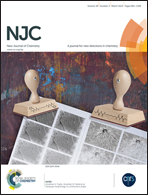Synthesis, crystal structure investigation, DFT analyses and antimicrobial studies of silver(i) complexes with N,N,N′,N′′-tetrakis(2-hydroxyethyl/propyl) ethylenediamine and tris(2-hydroxyethyl)amine†
Abstract
The synthesis, crystal structures, DFT and antimicrobial studies of three novel complexes of silver: [Ag(THEEN)]2(PIC)2 (1), [Ag(THPEN)]2(PIC)2 (2) and [Ag(TEAH3)2](PIC) (3), have been reported in the present work, where THEEN/THPEN (N,N,N′,N′′-tetrakis(2-hydroxyethyl/propyl)ethylenediamine) are tetrapodal ligands and TEAH3 (tris(2-hydroxyethyl)amine) is a tripodal ligand. Complexes (1) and (2) are dinuclear, whereas (3) is mononuclear. Complex (1) adopted a see-saw geometry with coordination number four, whereas (2) and (3) are five coordinated. Complex (2) acquired distorted square-pyramidal geometry, whereas complex (3) acquired distorted trigonal-bipyramidal geometry. Extensive hydrogen bonding interactions have been found in all three complexes. The primary coordination sphere of the newly synthesized silver(I) complexes has been optimized, structural parameters have been calculated and the energy gaps of the frontier orbitals have been predicted with the B3LYP/6-31G/LANL2DZ level of theory. Structural parameters from the crystallographic and DFT studies are in good agreement with each other. The relatively smaller calculated HOMO–LUMO energy gaps (HLG) suggest charge transfer transitions. Antimicrobial studies have been performed with the new silver(I) complexes against gram +ve bacteria (Staphylococcus aureus), gram −ve bacteria (Serratia marcescens, Sphingobium japonicum and Stenotrophomonas maltophilia) and fungal species (Candida albicans, Aspergillus niger and Saccharomyces cerevisiae). Dinuclear complexes (1) and (2) exhibited remarkable results. All the synthesized silver(I) complexes have been proven to be better antibacterial and antifungal agents, even than their standard drugs (ciprofloxacin and fluconazole) and can be used as effective antimicrobial agents and potential drugs in the future.


 Please wait while we load your content...
Please wait while we load your content...